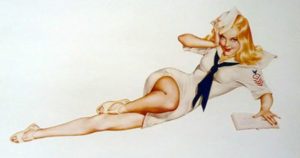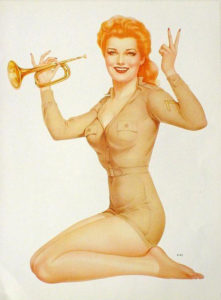 It’s not surprising that through the work of artists, writers, and thinkers in all of history, you can find a window into the world they occupied and the social values that influenced their work. It’s also not surprising that the Second World War became the focal point or the backdrop of many works of art and fiction during the 40s and 50s.
It’s not surprising that through the work of artists, writers, and thinkers in all of history, you can find a window into the world they occupied and the social values that influenced their work. It’s also not surprising that the Second World War became the focal point or the backdrop of many works of art and fiction during the 40s and 50s.
Though government sponsored information propaganda didn’t formally begin until 1942, storytellers, songwriters, and artists made full use of their talents to rally public sentiment in their own respective ways. Their works of art became a morale booster for young men in the army, as they served as a constant reminder of the values and freedom they were fighting for.
Notable examples include the plethora of songs written and recorded during the peak of the war. These were the songs that evoked strong patriotic feelings and courage among soldiers fighting overseas. One particular song, however, rose to fame for evoking feelings of a primordial nature – “I’m gonna buy a Paper Doll” which circled around the concept of forbidden romance. This song held the top position on the Billboard singles chart for twelve consecutive weeks from November 6, 1943, to January 22, 1944. 
“I’m gonna buy a Paper Doll that I can call my own
A doll that other fellows cannot steal
And then the flirty, flirty guys with their flirty, flirty eyes
Will have to flirt with dollies that are real.
When I come home at night she will be waiting
She’ll be the truest doll in all this world
I’d rather have a Paper Doll to call my own
Then have a fickle-minded real live girl.
I guess I had a million dolls or more
I guess I’ve played the doll game O’er and O’er
I just quarreled with Sue, that’s why I’m blue
She’s gone away and left me just like all dolls do.
I’ll tell you boys, it’s tough to be alone
And it’s tough to love a doll that’s not your own
I’m through with all of them
I’ll never fall again
Say, boy, whatcha gonna do.
I’m gonna buy a Paper Doll that I can call my own
A doll that other fellows cannot steal
And then the flirty, flirty guys with their flirty, flirty eyes
Will have to flirt with dollies that are real.
When I come home at night she will be waiting
She’ll be the truest doll in all this world
I’d rather have a Paper Doll to call my own
Then have a fickle-minded real live girl.”
Written by John S. Black of The Mills Brothers in 1915 after he had a falling out with his girlfriend, the song invokes certain feelings. The lyrics revolved around an idealistic view of female beauty that the writer wished to possess, and subsequently hide from everyone’s ‘flirty, flirty eyes.’ These emotions resonated deeply with the young men who had to endure months of hardship in the battlefield, away from their family and partners.
 These same emotions were likely behind the boom of pin-up posters during the war as well. Founded in the 1890’s by a Parisian artist, Jules Cheret, the pin-up poster was all about showcasing curvaceous and sexually attractive women. Women were used as the subject in an attempt to capture the viewer’s attention and to make sales. A few decades later, pin-up posters had spread to the rest of the world.
These same emotions were likely behind the boom of pin-up posters during the war as well. Founded in the 1890’s by a Parisian artist, Jules Cheret, the pin-up poster was all about showcasing curvaceous and sexually attractive women. Women were used as the subject in an attempt to capture the viewer’s attention and to make sales. A few decades later, pin-up posters had spread to the rest of the world.
When The Great War came around, the United States commissioned the Division of Pictorial Publicity to create propaganda tailored to lure young men into recruiting for the war. This was done through the sexually charged nature of pin-ups and other such media outlets. As men left to fight, women back home grew increasingly fond of their new-found freedom; freedom that gave rise to wearing what they wanted which marked a decided shift in society’s acceptance for such openness.
Alberto Vargas was well-known in the 1940s as the creator of recognizable World War-II era pin-ups for Esquire magazine known as “Varga Girls.” Between 1940 and 1946 Vargas produced 180 paintings for the magazine. The nose art of many American and Allied World War II aircraft was influenced from these Esquire pin-ups, as well as those of George Petty, and other artists.
As a result, the Second World War brought about the golden age of pin-ups. From the walls of barracks to the fuselages of high altitude bombers, American sweethearts silently cheered on each soldier, and beckoned them to fight harder for her. And fight harder they did because these lovely femmes fatales were the only immediate distraction that kept soldiers from dwelling on certain death. 